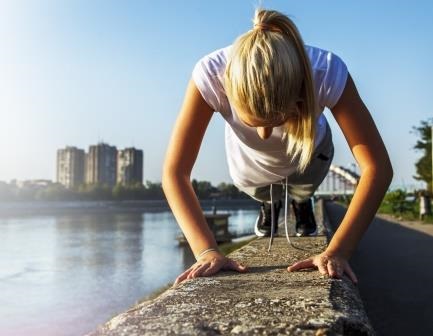
You know exercise is having a moment when leisurewear is dominating the catwalk and fashion pages. But what about the less glamorous side of exercise women rarely talk about – that sudden damp sensation in your pants as you sink that three-pointer, put away a cross-court winner or Downward Dog? Fabulous.
Wetting your pants while exercising might not be something you willingly admit to, but it is incredibly common and doesn’t discriminate according to how fit you are. In fact, elite athletes are three times more likely to suffer from stress urinary incontinence - the correct term to describe bladder leakage caused by exercising, laughing, coughing, sneezing or lifting.
While there are a different reasons for bladder leakage (the Continence Foundation of Australia’s excellent website explains the different types of incontinence and causes), most of the blame can be levelled at weak pelvic floor muscles. You can read more detail about these unsung heroes and how to whip them into shape, but when it comes to exercise, you need to remember your pelvic floor muscles are the ones doing most of the heavy lifting, so it pays to be aware of what exercises stress them the most, namely:
- running
- jumping
- star jumps
- skipping
- boxing
- sit ups, curl ups or crunches
- deep lunges or wide-legged squats
- lifting or pressing heavy weights
- double leg lifts (usually done with ab exercises)
- high-impact exercise classes that involve jumping and running, and
- sports involving stop start running and rapid direction change, e.g. tennis, netball, basketball and hockey
Is it any wonder Olympians are packing extra pairs of knickers!
If you experience any leakage (and aren’t representing your country), you might want to consider swapping to more pelvic floor friendly exercises until you strengthen your pelvic floor muscles with specific exercises.
Safer alternatives include:
- walking
- swimming
- seated cycling
- low-intensity water aerobics, and
- low-impact exercise classes
If your group trainer is one of those shouty types who favours terms such as “arse to the grass”, it’s important to remember it’s your body and your workout, so resist any pressure to push your pelvic floor beyond its limits. Instead, make modifications or small changes to the way you exercise:
- reduce the depth of your squats and lunges
- keep your legs closer together when you exercise
- use your knees for push ups or planks with less reps or hold times
- use lighter weights
- sit on a Swiss ball to support your pelvic floor when you use hand held weights
- use seated equipment where you can adjust the weights
- breathe out with effort as you push, pull, lift or lower a weight
- reduce the level of your abs program, and
- maintain a relaxed upright posture when you exercise.
Taking control of your own exercise program is easy. Complete pelvic floor safe exercise workouts designed by a fitness expert and physio.
The good news is pelvic floor problems can be fixed or improved to the point where you can resume your favourite sporting activities, without having to worry about wearing unnecessary pads or being restricted to black compression tights to hide embarrassing wet patches.
Making pelvic floor muscle exercises a regular part of your daily routine is one of the most effective ways to restore pelvic floor function. They can be tricky to do without initial instruction, so it’s worth checking in with a physiotherapist who specialises in the pelvic floor. Most can perform real-time ultrasounds (which are less invasive then they sound!) so you can observe your pelvic floor function, and monitor your progress. The Continence Foundation of Australia has a national directory to help you find a local specialist.
So, bottom line (pun totally intended), if you are wetting yourself when you exercise, don’t put up with it and don’t stop exercising. Help is available and there are plenty of pelvic floor friendly workout options while you work on restoring your pelvic floor muscle strength so you can resume your favourite sport or exercise.
Recommended for you:
Resistance exercises to resist

